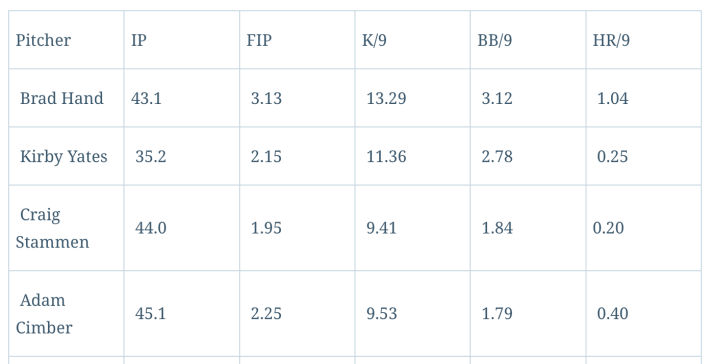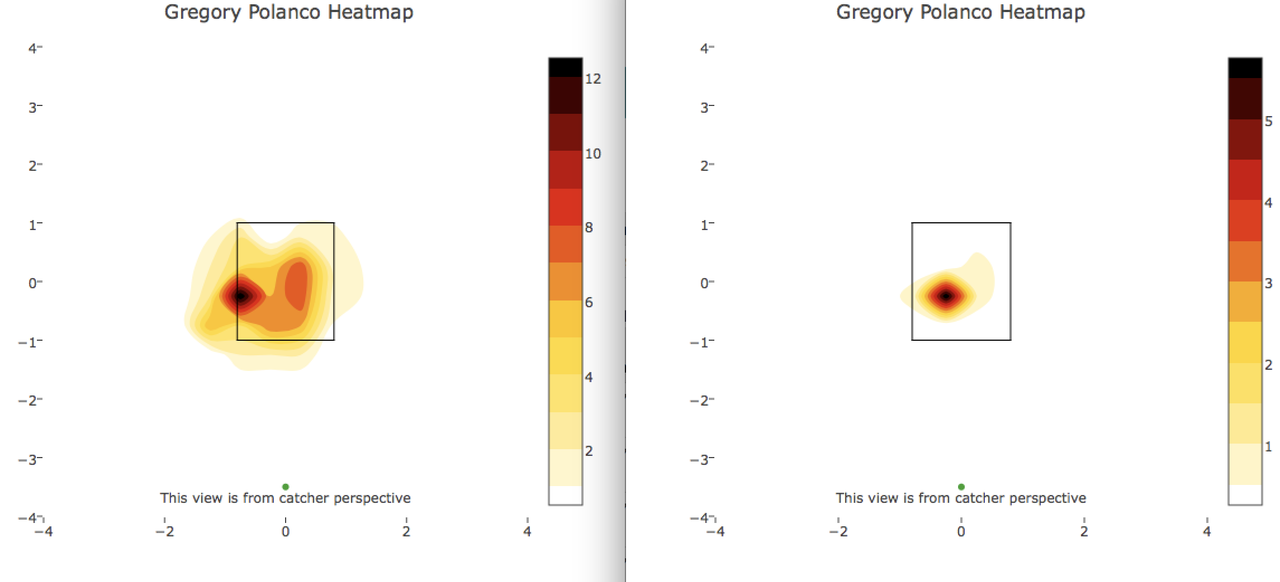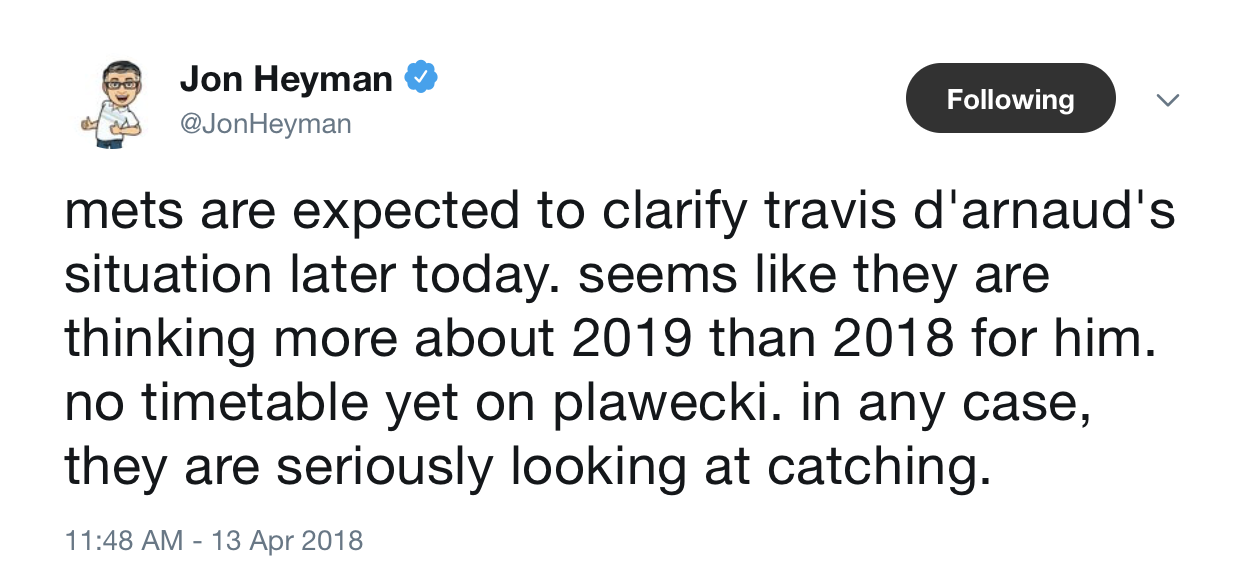Now that most rosters have been finalized ahead of opening day, there can be more specific speculation as to how certain groups of players on teams will perform.
As the use of bullpens becomes more significant in baseball, it is increasingly important to consider their performance. The Yankee bullpen is looking fantastic, which is fairly obvious to most at this point in time. A bullpen that is especially intriguing heading into this season is that of the Padres. While the team is not expected to contend this season, their bullpen is lining up to be quite unique.
Outside of Brad Hand, this is a group of relievers hardly anyone has ever heard of. Either because they simply have not played in the Major Leagues at all prior to this year, or have had mediocre performances in their time at the Major League level, these guys seem pretty lackluster to the average person.
This begs the question: Could the Padres have a trio of relievers similarly dominant to that of the Yankees’ Aroldis Chapman, David Robertson, and Dellin Betances? The idea is ambitious, however, the trio of Brad Hand, Kazuhisa Makita, and Kirby Yates have shown themselves to have the potential to be just as good this season. These three are players who have immense potential as relievers, whose variety of arm angles, and styles of pitching could be set to give opposing hitters fits this summer.
The bullpen is obviously led by Brad Hand, who will be the Closer for the Padres – What makes him unique is that he throws a lot of innings, and truly doesn’t care whether he’s pitching the ninth, or the earlier innings of a game. This means he can be used in the most high-leverage situation of a game, which is the ideal way for relievers to be used, a-la-Andrew Miller in the 2016 postseason.
Padres manager Andy Green said of Hand: “I’ve never been around a pitcher that takes the ball as willingly and as often as he does.” Hand pitched 79.1 innings for the team in 2017 – 6th most among all relievers in Baseball and first among Closers. With 11.8 K/9 in that many innings, take a look at the slider that generated a 21.2% whiff rate in 2017:

He didn’t locate this slider very well, but even when left up in the zone, the pitch is objectively good enough that it can still usually generate whiffs.
New Japanese pitcher Kazuhisa Makita is also on board with the Padres, who was signed from the Saitama Seibu Lions of NPB. A submariner who releases the baseball six inches off the dirt, Makita is arguably the most interesting reliever in the Major Leagues this year. His fastball has topped out around 81 mph this spring, and he also throws a curveball that has been clocked as slowly as 52 mph, and usually sits 56-59 mph.
It is unprecedented for a pitcher to throw at such a lower velocity than is traditional in the Major Leagues, though his 2.83 career ERA in the NPB suggests he is a very capable pitcher. His pitches and pitching style are so unique, that watching them gives one a better understanding of his pitching than words could ever describe.
He’s especially adept at painting the outside corner:

It’s certainly a very different arm angle, and he looks to have pretty good command of his pitches.
Makita seems to often throw his fastball on the outside corner more than anywhere else, based on his pitching style in his appearances this spring.
Though Makita is legitimately unafraid of throwing his pitches to any part of the plate, notably pitching up in the zone at times as he does here:

It will be especially interesting to see if Makita generates a ton of pop-ups from hitters in front of, and under his often 81 mph Fastball in 2018.
What is even more fun, is Makita’s curveball, because of how slow it is. It has been described as “Bugs Bunny” and “Eephus Curve” among other names thus far. Thus far though, the pitch has played as well as any other pitchers’ Curveball.
Here is his curveball:

As far as how his stuff will translate to success in the Major Leagues, the Padres have been liberal in allowing Makita to pitch his own style. Backup catcher A.J. Ellis made echoed this sentiment nicely: “we just want to let that style translate here as opposed to making him fit into what we think he should be.” Makita is unlike any pitcher the League has seen in years, so it is encouraging that the team will give him the independence to continue to attack hitters as uniquely as he did in Japan.
Amid all the power relievers looking to often whiz the ball past hitters with velocity, Makita has the chance to finesse his way to success in the big leagues. In an era in which hitters continue to counter power pitching with higher launch angles, and fly-ball swings, Makita’s pitches that rise on hitters will require legitimate adjustments from them. He probably won’t strike out a lot of hitters, though he figures to be a guy who will generate a lot of weak contact.
There is no standard for this kind of a pitcher in the modern era throwing at such a low velocity, and maybe he just won’t throw hard enough to ever be very good. However, if his approach to pitching is successful, the Padres will have found a truly rare kind of dominant reliever.
Another member of the bullpen is Kirby Yates, who almost struck out 14 batters per nine innings last season. His 13.98 K/9 was 5th best among qualified Major League relievers, behind guys including Kenley Jansen, Dellin Betances, and Craig Kimbrel. Yates upped his Split-Change usage to 14.2% in August, and 25.6% in September, which helped him to a 14.6% K/9 rate in those months. He gave up 17 hits during that time, yet not a single one of them was on a changeup, according to Baseball Savant. His split-change had a 22% whiff rate last season, easily being the best swing-and-miss pitch in his repertoire. Here is the split-change in action this spring:

He also throws a high spin-rate fastball often up in the zone, which from his shorter arm slot was hard for hitters to make solid contact on last season. Yates ranked third in swinging strike rate, at 17.4% – Among relievers who threw at least 50 innings last season, behind only Craig Kimbrel, and Kenley Jansen. With the increase in split-change usage, Yates could potentially take the next step as a reliever, and become even better than he was last season. Thus far, the results have been promising from a guy who was claimed off waivers from the Angels in 2017.
The three pitchers explored above, may not be likely to have the success they are sort of touted to have, as this article indicates. Especially in the case of Makita and Yates, people are not expecting them to be as good or comparable to Chapman, Robertson, and Betances. They probably aren’t going to be a three-headed monster, as the Padres hope.
Brad Hand is legitimately talented and should be recognized the way the members of the Yankees trio are. The point is that the other two pitchers have shown flashes of brilliance, in the case of Makita because of his unique style of pitching. Yates got hitters to swing and whiff at a level nearly as high as Craig Kimbrel, and Kenley Jansen.
Being a smaller market team, the Padres have to be more careful with their money than a team like the Yankees, who signed Robertson and Chapman to hefty free agent deals. Quietly San Diego might have found their own funky three-headed monster to anchor the late innings of their games this season. They’ve acquired and signed the aforementioned three relievers for a combined total of $7,145,833 in 2018 – The Yankees trio, in contrast, is due $38,100,000 in 2018 salaries according to Spotrac.
The team will never have the financial might of the Yankees, but they have shown a creative way to build a bullpen, that will be interesting to watch this season. Reliever performance is volatile, and the sentiment that these guys are nothing more than flashes in the pan is perfectly legitimate. What they have is a chance to be excellent relievers, and that chance is worth examining.
All Data used in the article was taken from MLB.com, Baseball Savant, Spotrac, and Brooks Baseball.





















